I savoured the moment. I had woken up and was not feeling particularly inclined to jump into the shower and run for a train. Today was Niigata day and I could take my time. Even though I did have to be in the next city along (Nagano) by the end of the night, the distance from Niigata to Nagano was a fraction of the distance I was used to travelling so far.
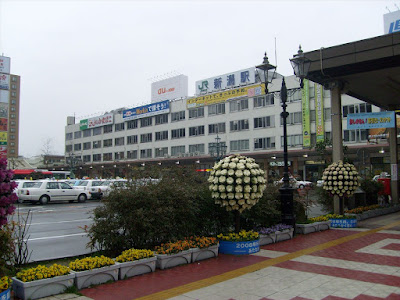
I managed to rouse myself at about 8.30am and left my big backpack at the hotel. Backtracking, I stopped briefly at the station again to check train times. The next train to head to Nagano was a Hokuetsu 6 leaving at 1pm, changing at
Naoetsu. I bought a ticket and headed quickly in the direction of the group of black spots on my map indicating tourist spots and silently cursing my selfish sleep-in. Heading out through the early morning traffic down the back streets, I passed a group of
crows who had worked out how to group lift a rubbish bag out of a bin and were now reaping the spoils. With no-one around they had the situation to themselves and were an almost comforting sight of nature in all the
high-rises around me.

Passing the
Niigata Telecoms tower, I followed my city map and headed on foot through the west side which was full of
partly-finished buildings until I came to the Yachiyo Bridge, one of the main crossovers to the north side of the Shinano river that cuts it in two. Over the other side, the embankment took me to the edge of
Hakusan Park, the start of the main sightseeing area, where a large pedestrian bridge unceremoniously straddles a much older road and twists and twines around like a demented rambler.
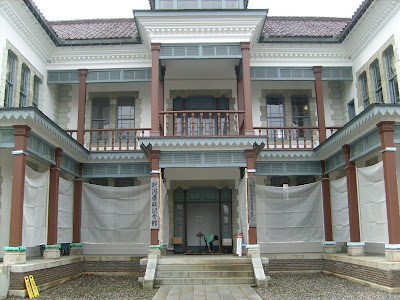
Taking a guess, I headed down a spiraling walkway to the road below and was greeted with the original
Prefectural Government Assembly Hall, a very western-style building from the late 1800's where the councillors of the day laid down the rules for the residents of the then much more town-sized Niigata.
Slipping off my shoes, (for the first of many, many times) I tiptoed alone around the 2-storey building, which had now been fit out as a museum complete with
display cabinets,
blown-up pictures of the building during construction and the surrounding area, though the
main hall had been left pretty much the way it was when it was filled with arguing and banter. Each of the rooms were kitted out with
western furnature, victorian fireplaces and period decor, with a smattering of Japanese ornaments and pictures to remind you where you were. Heading down the stairs back at the entrance, I was greeted by one of the curators, a middle-aged woman in a white cardie and we began the now quite familiar exchange of hand movements and repeated phonetic pronunciations. She wasn't going to let me get away that easily...

Just as we were making some communicative headway and we once again went around the ground floor buildings, she was joined by an older gent, who was the owner of the building. Not unreasonably, with the tourist season just about hauling itself out of bed at this time of year, they were more than happy to communicate with the strange-looking foreigner pointing like a doof at the walls and ceilings and
water filters donated from a shop in The Strand in London, a place I'd walked down about a fortnight earlier. After some personal guiding arond some of the rooms, pointing out the oft-missed ceiling decor adorned with intricate carvings of roses, they took me into their office room and we chatted for a while over coffee! At this point, my little Yorkshire Dales book came in handy to show them my part of the world and they cooed and were genuinely interested at the picture-postcard versions of the litter-strewn and often rainy countryside I was used to.

I wasn't sure how I got there but myself, Master Ukon Tugue, (as the gentleman turned out to be called) and now
two assistants were getting on swimmingly, despite them knowing as much English as I knew Japanese. He gave me his personal card, and I gave him a hometown postcard back, with a little greeting on it. They posed for a picture outside the place (of which it was clear they were both intensely proud) and they saw me on my way.
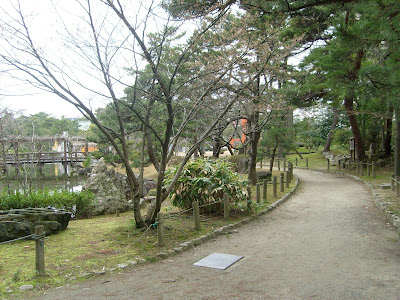
Pointed around the side and through a small gate by Tugue-san, I entered into a Japanese Stroll Garden, which was actually part of the Hakusen Park.
Several large sculptures hidden between the trees lined the pathway on one side, with a perfectly
flat and serene lake on the other, seemingly unaware that it was in the middle of a city. A little way on, the pathway opened up and the twin Torii gates, one
concrete and the other
bright red painted steel flanked me on either side of the main pathway. As I followed the main pathway, it was clear that the maintainers of the garden had a challenge on their hands keeping things from
falling over, perhaps due to heavy winds or showfall, but many of the trees in the park were being held up and were often pretty diagonal, as if it was their duty to halt the natural growth-decay cycle of these trees and keep them growing indefinitely.
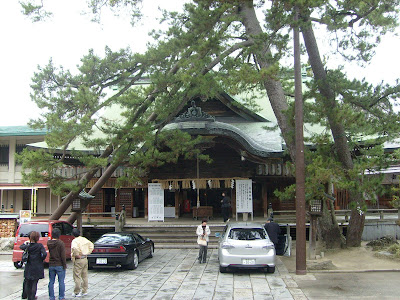
At the end of the pathway was the
Hakusen Jinja Shrine Gate, which by this point in my shrine- viewing experience looked pretty big at the end of a set of lanterns in a slightly errie and empty area. Inside the main courtyard, there were more poles holding up more trees, but this time joined by my first Shrine experience. It was also the dawn of my realisation as to the point behind the mysterious
wooden slatted boxes that appeared everywhere I had been so far that had looked remotely touristy. They are donation boxes, with the inbuilt temptation within them to lob your donation into them from a distance, which I have also found, is frowned upon.
The shrine, as with most of them, have as well as the donations box, a large rope hanging from the ceiling with a metal sphere containing stones at the top. Not being a religious man, I did not immediately take to paying my respects. Someone clearly seeing that I was hesitant stepped up in front of me, threw 100yen into the box, shook the rope, and clapped his hands twice, bringing them together and closing his eyes for 5 seconds, then leaving with a smile. Sheepishly, I copied him, and I had to admit, it felt
pretty good to do. I guess if there was going to be a religion to adopt '
when in rome', I might as well make it one that sees the beauty in the creation around us rather than a '
my gods better than yours and i'll kill your people until you agree with me' approach. Sorry, god-botherers out there, but I aint returning to that flock.
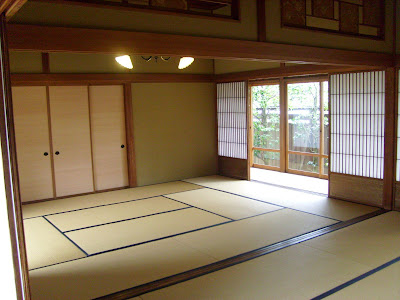
Quite pleased with my new-found and entrely superficial religious experiences, I pressed on under a gate lined with thousands of
wooden plates and those familiar
paper ribbons carrying wishes attached to the walls, and emerged in front of
Enkikan, a traditional tea-ceremony building that had been dismantled from its original location and moved into the park. With enthusiasm building from my succession of new experiences I tiptoed through the gate into an
area clearly designed for removing shoes. After some random pushing/knocking, I found out how to get into the place and was immediately greeted by a number of surprised women. I guess that the tea ceremonies/flower arranging spiel in my book should have suggested to me that it would be a largely female congregation, and a large foreigner, stooping uncomfortably to avoid cracking his head on the beams must have come as a shock, but nevertheless, they allowed me to stay and look around, so long as I was quiet and didn't go opening any more random doors. Enkikan was a very traditional wooden Japanese house. A succession of adjoining rooms, connected together by a
side corridoor, which looked out onto a
tranquil garden outside. Each room was pristine, with tatami mats and delicate sliding doors, and looked like they had just been made, despite being hundreds of years old. Impressive though it was, a little bit of looking into empty silent rooms was enough and I moved on.
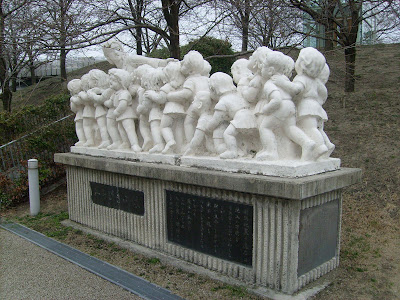
Outside, I was back in the main park area and to my right was a walkway up to the imposing pedestrian bridge I had come in on. Looking at my watch there wasn't a lot of time left to look around, and I had passed several imposing-looking structures on my way, which I was now at the other side of. I briefly walked by the
local baseball stadium where a few people were shouting but not a lot else was going on, then headed to the
Music and Culture Hall, which had clearly been made with a lot of 1960's decor in mind, the main centerpiece being a massive new-age chandelier in the entrance hall. Much though I would have loved to have seen some of the
things that were on, I was beginning to get that feeling of train timetable dependance, so I exited out the other side and headed for the next spot on my map - the Next21 building a good 10 minute walk to the east.
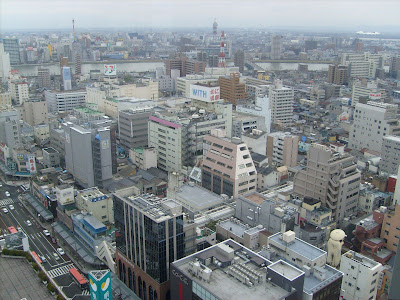 Shaped like a pencil
Shaped like a pencil, the building is one of many in Japan that has a viewing platform, so after some hurried limping (my feet were starting to complain) I made it there, up and back down again in about 10 minutes, with a couple of pictures to boot. On the way down the elevator, a strange sight stood out from the hundreds of buildings and
nearby cemetaries - a giant (and I mean Giant - it was larger than a house) statue of a
wandering monk. Checking both compass and watch it was on the way, so I headed in its direction, and after finally finding it was ushered towards the river by an over-helpful bloke carrying a big bunch of flowers that dwarfed him who thought I was lost (which, to be honest, I was a bit). Recovering my bearings I got back over the
Bandai bridge and - after nearly forgetting - pegged it back to the hotel to retreive my larger backpack. I got onto the train with about 2 minutes to spare. Getting some food over the course of my little 5-mile journey would have been nice but it was clearly a luxury in the time I'd given myself.
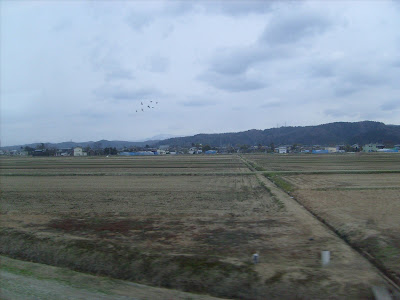
The train to Naoetsu showed some of the less pretty sights of Japan; as the rice fields stopped, the
large concrete overpasses started, dwarfing the old villages they stamped through on the way to somewhere and damn-near blocking out the sun for them. As soon as I left the train at Naoetsu, it was clear by my ticket I would need to rush again for the next one, so no sightseeing and no food there either. As I boarded my second train of the day and started taking pictures, a group of Japanese teens smirked at my deschevelled self and outright laughed when I banged my head on the overhead baggage trying to get a picture. Chattering amongst themselves thinking I could not work out what they were saying, they referred to me as an American. Not too far from the end of my tether after running across the station for the train, I said 'Ingrisu' (English) in my best
Batou voice and strode into the next carriage, content by their sudden surprised silence that I had given them the impression I knew exactly what they had been saying.

Naoetsu to Nagano was a much more picturesque experience, the snow
reappearing here and there as the train wound its through the mountains. Unsettlingly, this had the effect of sending my compass in all directions rather than the general SW direction I would have been the most comfortable with it sticking to. Several times, I had to check with the other passengers whether it was Nagano we were heading towards. Again, we
touched the tip of the Sea of Japan on the north coast, before finally heading inland and swapping direction at
Nihongi, pointing us squarely at the intended destination.
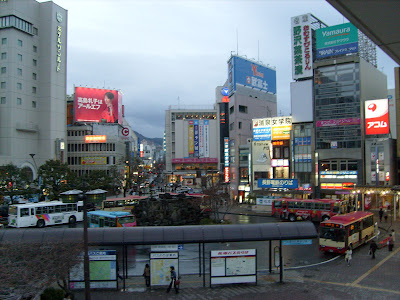
By the time I had got to Nagano Station, the intended hour-or-so's journey according to the map had turned into three and a half, and the best of the light had disappeared from the day. However, there was still some left, so after finding the mercifully closeby hotel (literally across the road) I showered and headed up Chuo-Dori, the
main street up the centre of Nagano, at the end of which is the Zenko-ji temple. I had a mission - to find the fabled curry house called
Joy Guru, purveyors of simple Indian Kewzeen located somewhere up the main street. Since arriving, I had been curious to see what sort of spin the Japanese had put on this fantastic style of eating, and Joy Guru was the first restaurant I'd heard of in a place I was visiting. I walked, and walked, and then some more, but could not find it, until I came back down the other side of the road and clapped eyes on the largest sign I could get away with missing.
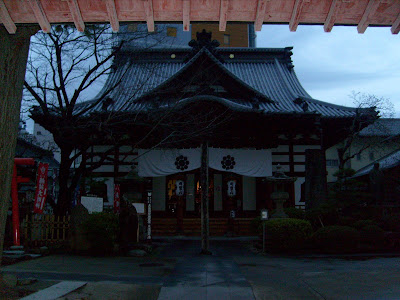
I will say this now, and will repeat it later. The Japanese cannot do Indian meals. Joy Guru happened to be the best of the ones I had tried during my trip though, and even though their rice was sticky like their rice cakes, and the menu was pretty basic (only a couple of kinds of curry, one rice style and some strangely cut naan breads) the meal was filling and the service very accommodating, to the point where I was digging around my phrase-book for something both clever and full of praise for the poor woman who served me and several others as if she had twenty arms.
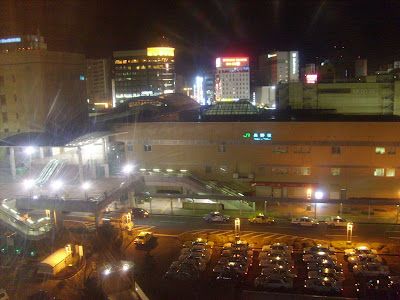
Pleasantly filled with warm curry, I ambled back down Chuo-Dori, through the station and back into the hotel at about 11pm. It had been a good day.
No comments:
Post a Comment